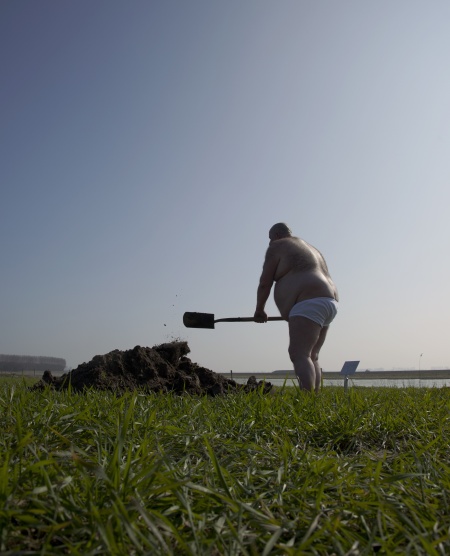User:Astrid van Nimwegen
Trimester 2, 2012.
NOTE: All documentation material, PDF, photos, videos, etc, must be uploaded to the wiki. No embedding or third party hosts allowed, for obvious archiving issues ;)
NOTE: Please use "your name, the title of your project, the year" as page name.
Description
350 words including aims of the theoretical and practical research as well as its outcome.
In the second trimester I worked on a short video for the Boerhaave museum. For this I asked an overweighted man to dig his own grave, wearing only white underpants. I edited the material back to three minutes. I never edited my video's before so all this is new to me and I ask myself the question if I am losing my concept which is carefully build up throughout the years. Does the work need a cut or how can I use a cut in a way that it adds something to the work?
Media
Photos
Video
optional unless the final outcome of the project, or one of its main components, is a video/film/animation.
- allowed containers/codecs combos:
- MP4:
- Video Codec: H.264 (3-5 Mbps data rate)
- Audio Codec: AAC (160kbps or 384kbps if 5.1) or MP3 (-V0 or -b 320)
- MP4:
- resolution: 720p if source >= 720p, native resolution otherwise, progressive.
- FPS: 24, 25, 30.
- Sample rate:
- 44.1kHz if source is 44.1kHz or 88.2kHz
- 48 kHz if source is 48kHz or 96kHz
- 44.1 kHz for everything else.
Audio
optional unless the final outcome of the project, or one of its main components, is a sound piece/track.
- allowed containers/codecs combos:
- Ogg: Vorbis (-q 6) preferred
- MPEG: MP3 (-V0 or -b 320)
- FLAC (-8)
- Sample rate:
- 44.1kHz if source is 44.1kHz or 88.2kHz
- 48 kHz if source is 48kHz or 96kHz
- 44.1 kHz for everything else.
- Do not transcode! For instance, if the sound generated is directly an MP3, do not re-encode it with the settings above or with a different codec. Only encode original uncompressed or lossless compressed sources.
Essay
Draft essay: Annotations of one film by Bresson and one by Tarkovsky.
Annotation of one of the texts written by Sontag, Schrader or Tarkovsky.
Quotes from ‘Notes on the cinematographer’.
Essay about in which way these writings and working methods are connected to my practice and thoughts.
Also cinema’s ‘claim on the real’: Why and how Bresson distinguish Actors from Models and what, according to him, the difference is between cinema and cinematography.
Films as an ‘experience’ instead of telling a story.
Under construction:
In ‘Transcendental style in film’ (1972), Paul Schrader writes about the similarities in films of Bresson, Ozu and Dreyer. The films are brought together not by their theme but by the similarities that are found in their style. ‘Their unique quality is the one which brings them together: their ability to transcend personality and culture through style’ (‘Transcendental style: A Primer, Schrader P. 1972) Schrader states that the transcendental film has three stages; the everyday, disparity and stasis.
‘The everyday suggest that the world is cold, unfeeling, and without emotion or meaning………there is no potential for emotion or meaning; there is no place where it can come from’ (Schrader, P)
‘Disparity introduces an overpowering, irrational and undefined sense of commitment (a “passion”) into the cold, ordered everyday. There is no reason for this passion to exist; yet it exists nonetheless. Disparity culminates a decisive action, an action (such as crying) in which the passion actually breaks through the unemotional structure of everyday’ (Schrader, P)
‘In stasis, the form of the film returns to the hard stylization of the everyday- but with a new purpose. The world is like it once was, but now one understands that the transcendent is just beneath every realistic surface.’ (Schrader, P)
To give this concept further understanding, Schrader brings an example; ‘when I began to study Zen, mountains were mountains; when I thought I understood Zen, mountains were not mountains; but when I came to full knowledge of Zen, mountains were mountains again’ (Schrader, P)
‘The purpose of transcendental style is not to make you emote but to make you understand. The three stages of transcendental style are designed to gradually replace empathy with awareness.’ (Schrader, P)
All these quotes seem necessary to get some understanding of the term ‘transcendental’.
In Bressons ‘Notes on the cinematographer’ notations about his thinkings and working methods are brought together. He explains that there is a difference between cinema and cinematography. Cinema is a copy of theater where cinematography is the only true artform. Bresson uses models instead of actors.
Bibliography:
‘The library of Babel’ Jorge Luis Borges
‘Notes on the cinematographer’ Robert Bresson
‘Spiritual style in the films of Robert Bresson’ (1964) Susan Sontag
‘Transcendental Style in Film, Ozu, Bresson, Dreyer’ Paul Schrader
‘Sculpting in Time’ book by Andrei Tarkovsky
Films:
‘Pickpocket’ (1959) Bresson
‘L’Argent’ (1983) Bresson
‘Au hasard Balthazar’ (1966) Bresson
‘Les Anges du peche’ (1943) Bresson
‘Journal d’un cure de campagne’ (1951) Bresson
‘Offret’ Andrei Tarkovsky
‘Ivan’s Childhood’ Andrei Tarkovsky
Additional Information
optional
- Project URL (if lives on an external site)
- extra wiki links (in case you have relevant notes/journals/documentation in your User: page, this is useful particularly if you have been asked to articulate further or refine your project during your assessment)
- Animated GIFs

